This review of the Bubblebum booster seat is written by certified Child Passenger Safety Technician Melissa Conn and may contain affiliate links.
When do you know you’ve reached the pinnacle of traveling light with kids? I now have the answer: when you can safely use a tiny inflatable booster seat for your kid as you gallivant around the world, leaving even the lightest travel car seats in the dust.
What is this magical tool that you need in your family travel arsenal? It’s the Bubblebum inflatable booster seat! It’s no exaggeration to say that it’s revolutionized our family’s travels. In this Bubblebum review, I’ll share my insights after a year of full-time use: what it is, pro tips to use it most effectively, the best features and potential downsides. I’ll even explain where we fall in the great “Bubblebum vs mifold” debate. Keep reading for one of the most in-depth Bubblebum booster seat reviews you’ll find on the web.
Read more: Choosing the best portable booster car seat for travel
What is the Bubblebum booster seat anyway?
The Bubblebum is an inflatable backless booster seat that’s perfect for families on the move – this thing is downright tiny compared to conventional car seats and even traditional backless boosters. It’s an extremely lightweight booster seat for travel but it still feels substantial and safe in your hands.
The Bubblebum booster seat safety standards are in line with government requirements, and they have models satisfying both the American and European testing requirements. It keeps kids safe by boosting them up a few inches and then holding the adult seat belt in place using a series of easy-to-operate clips. It even passes crash tests when deflated, just in case. How does it do that? The inside isn’t just empty like a balloon; instead it has approximately an inch of memory foam to help it maintain its structure, along with webbing (just like a seatbelt) to anchor the seat belt guides. Not bad for an ultra-portable booster seat that clocks in at just 2 pounds!
Inflatable booster seat safety concerns
In 2022, the IIHS made waves by revoking its fit ratings for inflatable booster seats (which also includes the hiccapop uberboost). To be clear, they haven’t been rated as poorly fitting, and Bubblebum still passes all Federally mandated crash testing. The decision is based on a computer modeling study of how a 6 year old’s body would move in a crash.
Finite element modeling has the potential to provide a lot of new information in the car seat world, but it is still a new tool. It’s not clear how well findings such as these translate to real-world crash outcomes. The Bubblebum has been on the market for over a decade and it meets both US and UK crash testing standards. Those standards themselves are certainly due for a refresh, but at this time they’re what we have available. To date there have been no recalls of the product nor has anyone reported an outsized number of injuries sustained by children riding on Bubblebums in crashes.
In the child passenger safety world, we talk about good, better and best practices. We know that allowing a child to ride using an adult seatbelt without a booster seat can result in death or life-altering injuries. We also know that out in the real world the Bubblebum does a very good job of positioning the seatbelt on a young booster rider’s body.
There are many travel situations in which parents just can’t realistically carry a traditional booster seat with them and Bubblebum is still a “good” option even if it is no longer considered “best” in the eyes of some. It remains a valuable tool in the toolkit for now.
All that said, your comfort level as a parent is extremely important. If reading this discussion leaves you feeling uneasy about Bubblebum there are a few other options to consider:
- Ride Safer travel vest – see my full review or save $11 with coupon ‘VOYAGE’
- Cosco Rise LX – traditional booster seat but a little lighter and more compact than others and extremely affordable
Read more: Bringing your booster seat on an airplane
Who is the Bubblebum inflatable booster seat for?
The minimum requirements to use the Bubblebum travel booster car seat in the US are 4 years old and 40lbs. Personally, I think that’s way too young in most cases; after all, many experts recommend keeping kids in a rear-facing car seat until as close to 4 years old as possible due to their physical development, and then to transition to a forward-facing harness for several more years. You may find some Bubble bum reviews showcasing very young children, but those probably aren’t written by CPSTs who understand how to keep kids safer in the car.
Why should you keep a 4 year old in a harness? The seatbelt is only effective if your kid uses it correctly 100% of the time. That means no reaching down for a dropped toy or water bottle and no slumping over when she gets drowsy from jet lag. If you’re traveling with a child between the ages of 3 and 5, check out this awesome portable car booster seat alternative.
I generally recommend the Bubblebum car booster seat for kids ages 5 and up – even better if they’re already 6. By 6 years old their bodies are better equipped to handle an accident and their minds are (hopefully) mature enough to understand the importance of staying in the right position. That maturity is one of the most important booster seat requirements and shouldn’t be taken lightly. My younger kiddo wasn’t ready for a backless booster seat until 7 because she was like a wet noodle when she fell asleep in the car!
Takeaway:
-Kids 5/6 and up: keep reading for our Bubblebum booster seat review, or check out the best travel car seat for a 5 year old for more options
-Kids 3-5: check out our Ride Safer Delight travel vest review or read about the best travel car seats for 3 year olds and 4 year olds
-Kids under 3: check out the best travel car seats for 1 year olds and 2 year olds
How do you use the Bubblebum?
The Bubblebum inflatable booster car seat is one of the easiest car seats we’ve ever used! There are a few simple steps, but it shouldn’t require more than a few minutes – and certainly no sweat or tears.
Setting up the Bubblebum
Since the Bubble bum arrives and is transported deflated and rolled up, you’ll need to inflate it first. There’s an easy to use valve in the back corner – just untwist, blow a few times, and twist shut. If you’re taking a taxi or Uber with kids, we recommend that you blow up the booster seat before the car arrives to speed the process.
Some people report that their kids find the Bubblebum to be unstable or tippy. That’s probably because it’s over-inflated – it really feels like a “bubble booster seat”. It doesn’t need to be so full that it’s going to burst, and remember that it still passes testing when deflated.
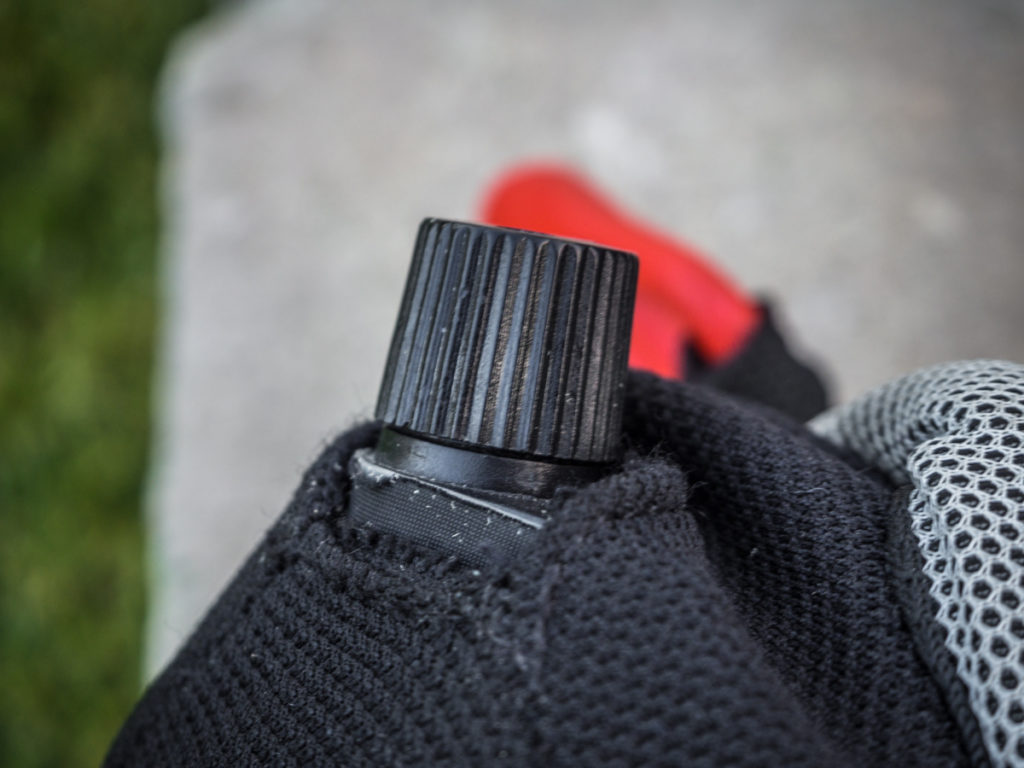
We did have one issue: after a full year of use, the Bubblebum seemed to be leaking. It would deflate over the course of a single car ride. Bubblebum replaced our booster with a brand new one for just the $7 shipping cost. (We only had that problem after leaving it fully inflated in a really hot car for a month while we were traveling. If you’ll be using it that way in extreme temperatures, I recommend bringing it inside with you or under-inflating.)
The only other piece of the Bubblebum that arrives in the package is the optional shoulder belt adjuster strap. You can quickly thread it around the webbing on the underside of the booster seat and just slide it left or right depending on which side of the car your kid sits on. Otherwise it works like the shoulder adjuster on any other backless booster seat. It took us a few tries to get the hang of balancing comfort with fit, but it’s easy enough to change the length.
Pro tip: When you’re traveling with the deflated Bubblebum, loop the shoulder belt strap around the Bubblebum and then run it through the red clip to keep your inflatable travel booster seat nicely packaged!
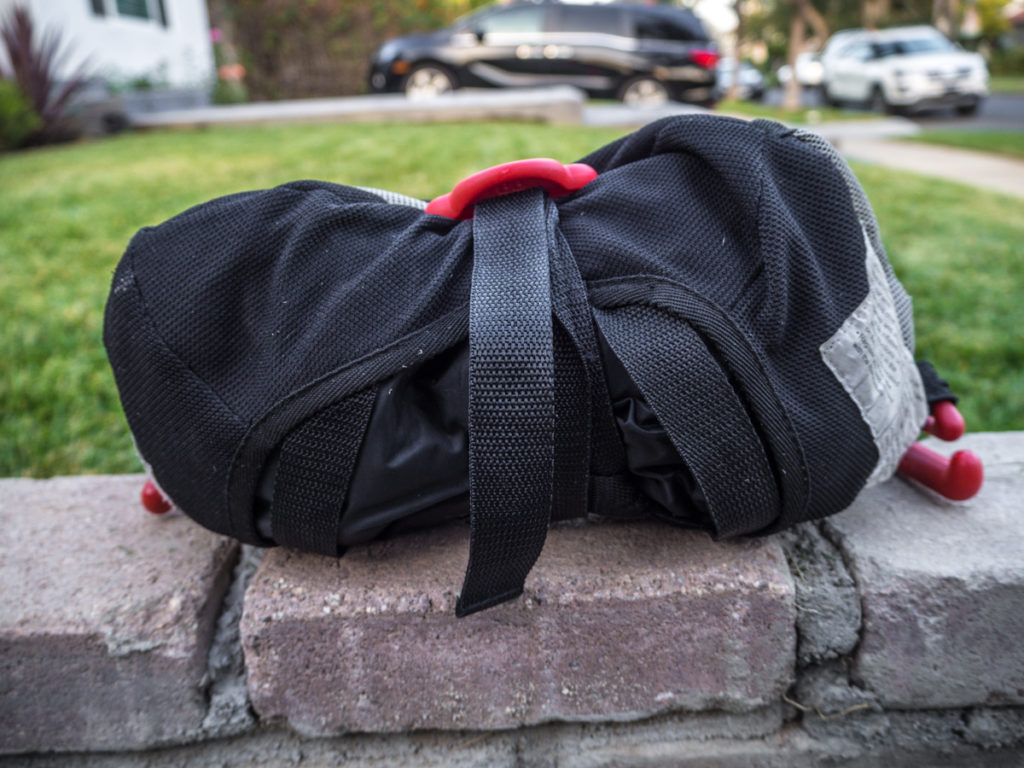
Securing your child on the Bubblebum inflatable car seat
Once you have the Bubblebum inflated, it couldn’t be easier to use. Place the Bubblebum on the seat of the car, have your child sit on it, buckle the seatbelt as usual and then thread both sides of the lap belt through the red clips near your child’s hips.
If you feel that your child would benefit from the shoulder belt being a little lower, run the webbing attached to the shoulder belt clip up along your child’s back on the side where the shoulder belt is, thread the shoulder belt through that red clip and then pull the tail of the shoulder belt adjuster strap until you like the fit. That’s all!
As you can see below, it’s an extremely narrow booster seat so you won’t have any trouble fitting it next to other passengers or car seat.
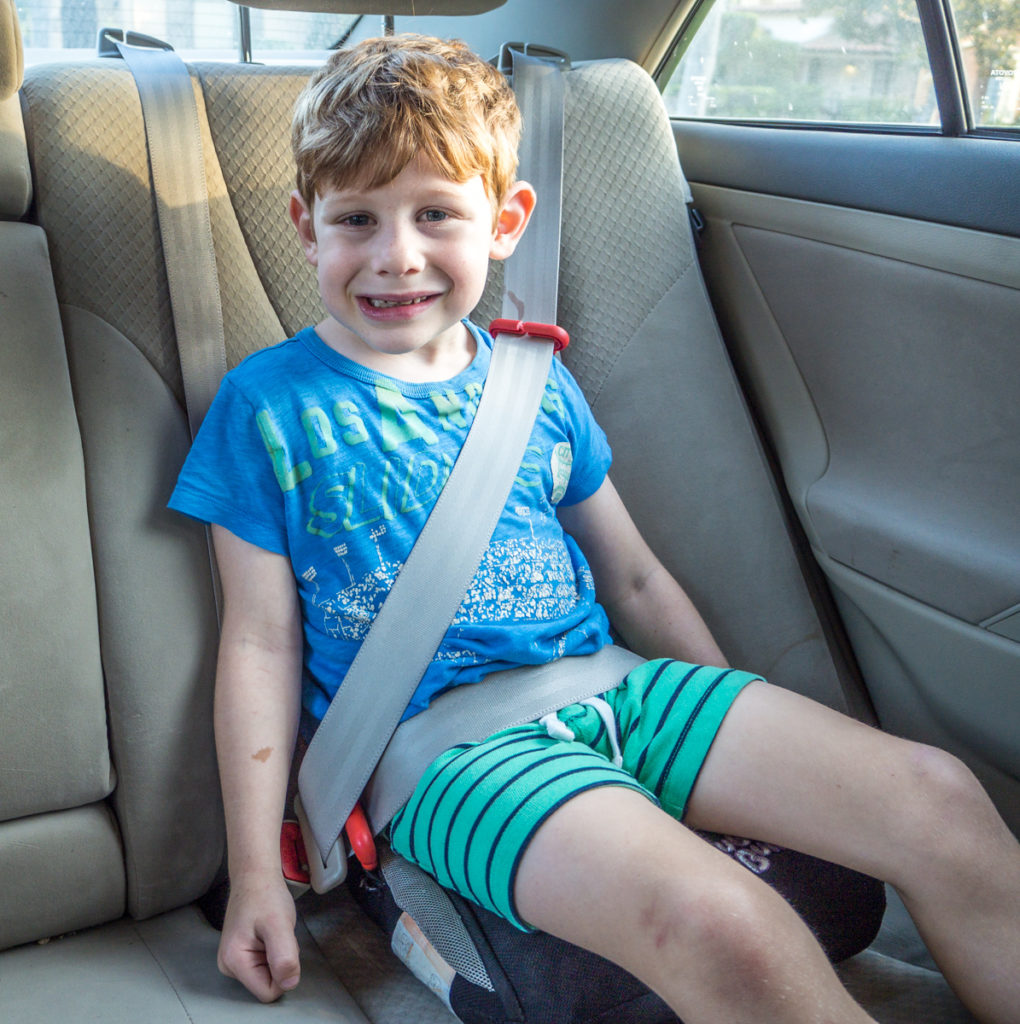
Since we often kept the same car for days or weeks at a time during our gap year, we usually left the shoulder belt and one side of the lap belt threaded through the red clips of the Bubblebum car seat. Then for subsequent car rides, our son could hop in and buckle himself and just thread the lap belt through the final clip. He could be secure in the car in a matter of seconds, and at 6 years old it was easy enough for him to do on his own.
Here’s a quick video demonstration:
Our Bubblebum booster seat review after a year of full-time use
When we left America for our family gap year, our son was just a week shy of 6 years old. We had done some booster training before our departure and he wasn’t generally a “car sleeper” so we felt confident that the Bubblebum was a safe choice for him. Our overall impression of the Bubblebum is extremely positive. Below are some advantages and disadvantages that we noted after a year of full-time use.
Advantages the Bubblebum blow up car seat
The biggest advantage of the Bubblebum compared to conventional booster seats is that it’s small and light. During our gap year, we usually put it in our carry-on backpack along with Ride Safer vest and a few electronics. It fit perfectly! Our son could also have easily managed the size and weight in his own backpack (if he didn’t have so much junk in there).
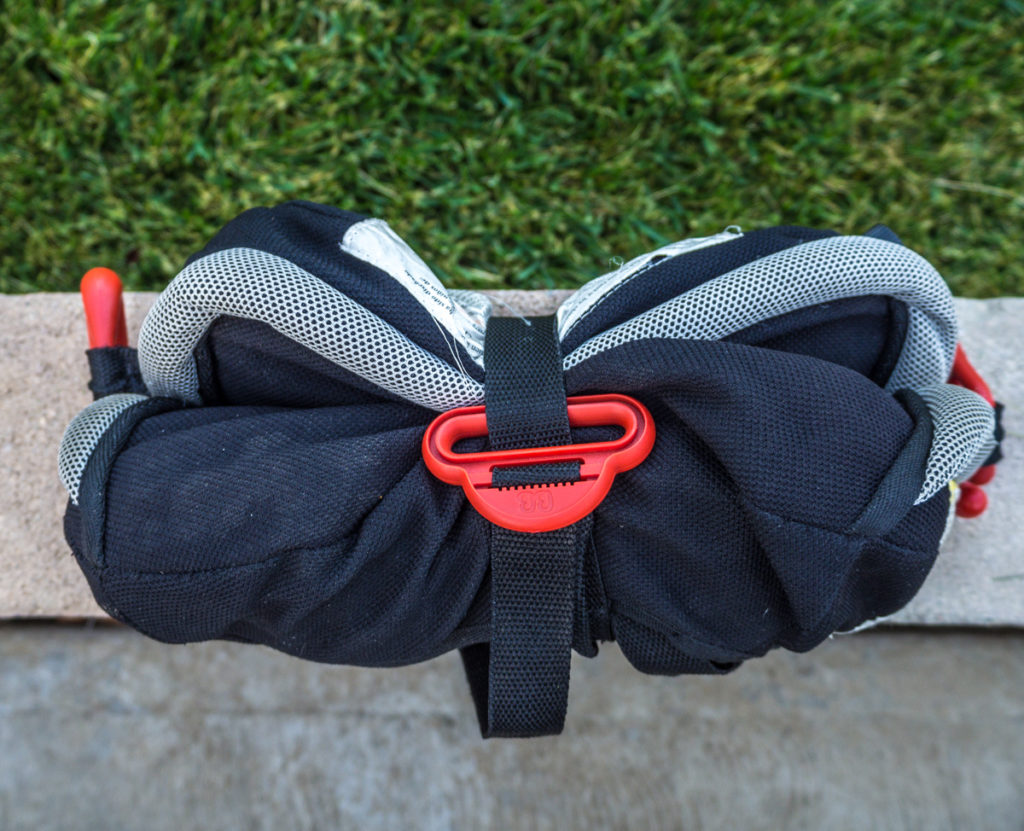
We used the Bubblebum blow up booster car seat in more cars than I can possibly remember and we always got a good belt fit. If you’re traveling to far-flung destinations, you’ll have no way of knowing what rental car or taxi will show up, so this consistency is extremely important.
For budget travelers, you’ll be happy to know that it retails for a very reasonable $29.99 . We found the Bubblebum booster cheapest price here.
The Bubblebum is also very easy for a child to use on his own, even if he’s a fairly new booster rider. It only took a few days for our son to get the hang of it! He still sometimes struggles with maneuvering the buckle and belt guides on his boosters at home because they’re wider than he’s used it.
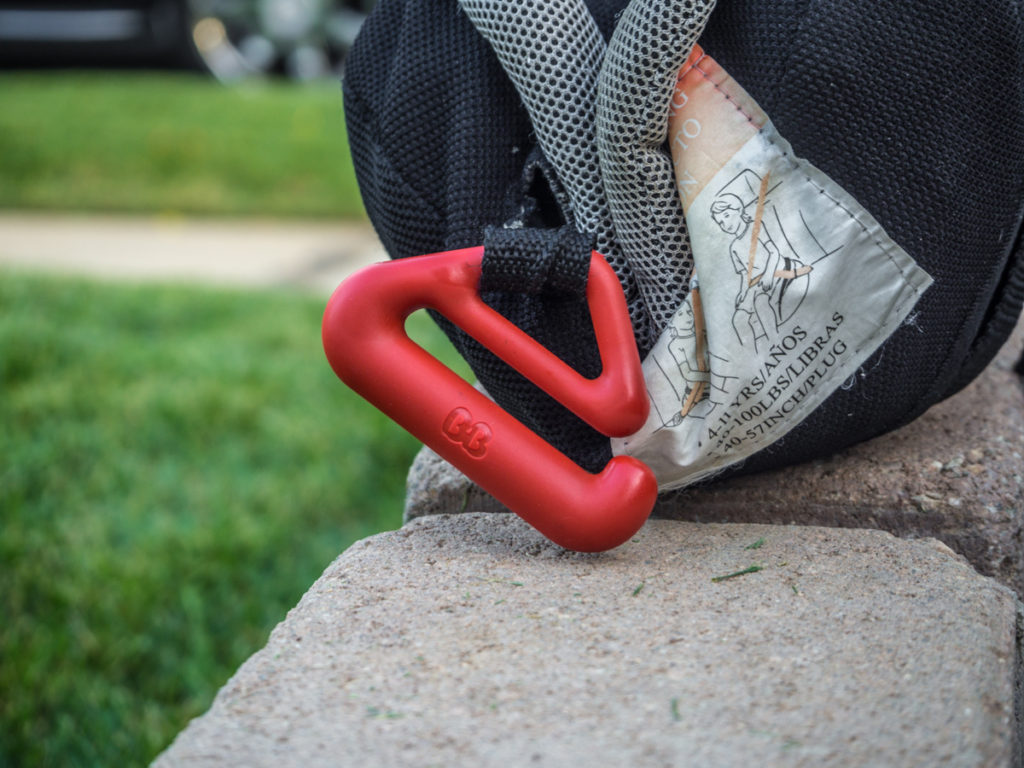
The Bubblebum is the narrowest booster seat available, which makes it a great choice for three-across situations (as long as your kid isn’t already the size of a small adult). We normally don’t give that much thought since we only have two kids, but we took tons of taxis and Ubers during our gap year, which often left me sitting in between the two kids! Thankfully it’s never a tight fit between a Bubblebum and a Ride Safer vest – each of them is basically the width of the rider.
The Bubblebum is also great to keep in the trunk at home in case we do a last-minute carpool or we have an out-of-town visitor and need the extra space.
Disadvantages the Bubblebum
Nothing is perfect, and there are some pitfalls with the Bubblebum just like with any other product.
First, there’s no head support for sleeping. Any backless booster will cause the same issue. When our son fell asleep, I’d either wake him up or just reach back and push him into place. If your child still falls asleep often (especially after a long flight) then check out the Ride Safer Delight travel vest – see our full review here or check prices here. Even a highback booster like the Peg Perego Viaggio Flex 120 is more likely to keep a car sleeper in place.
Second, some kids tip or slide on the Bubblebum. There are a lot of factors that come into play. All backless boosters require the rider to be mature enough to sit calmly in place, so a wiggly kid shouldn’t be using the Bubblebum. But if you combine a wiggly kid and slick leather seats, you can definitely have an issue. The Bubblebum can also feel tippy to kids if it’s 100% inflated. There’s no gauge on the side or anything, but if it seems really full try letting just a bit of air out to make the seating surface squishier – it still passes testing fully deflated so it’s more about comfort and helping your child stay in position 100% of the time.
Third, one issue we didn’t encounter but that’s worth mentioning is that the seating area of the Bubblebum is rather small. The current recommendation is for kids to use a booster seat until the pass the “5 step test”, which could be close to age 10 – or older. The Bubblebum just isn’t that big! It’ll work from a safety perspective, but big kids might not find it the most comfortable. If you want a small booster for a big kid, take a look at the Graco RightGuide – it doesn’t fold, but it doesn’t take up much space and will be great for home as well.
Bubble bum booster seat for long-term use
The Bubble bum car seat technically expires four years after manufacture. However, I was assured by a representative over email that families can use it four years after first use. I think it’s reasonable to stay somewhere between those two dates, as you don’t want to run the risk of the memory foam degrading or a frequently rolled and unrolled bladder developing a hole. But given the bargain price, we aren’t too concerned about the lifespan – it works out to the price of two coffees per year.
The Bubblebum inflatable booster seats come with a one year warranty(not bad when you consider that it’s 1/4 of the item’s lifespan).
After more than a year of use, constantly rolling and unrolling and leaving our Bubble bum booster seat in a boiling hot car during our France roadtrip for a month… it finally kicked the bucket. We suffered the dreaded Bubblebum deflating issue! Thankfully their excellent customer service team sent us a brand new replacement for just $7 to cover shipping.
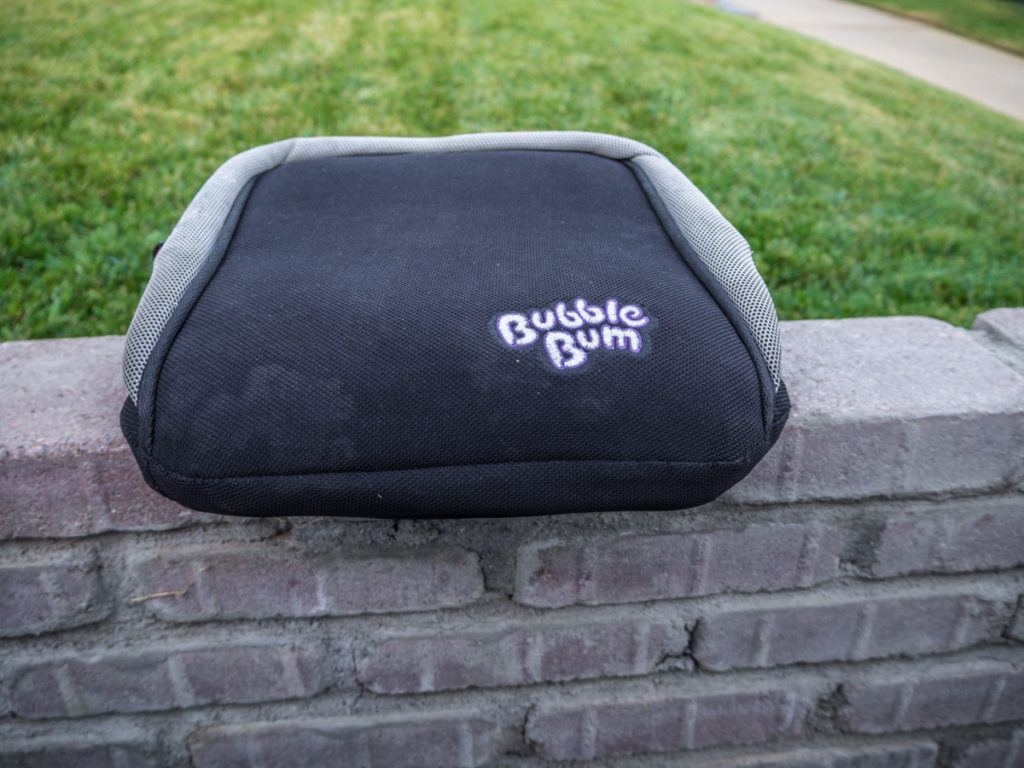
Bubblebum vs mifold booster
If you’ve been anywhere on social media over the last three years and the internet thinks you’re a parent, you’ve undoubtedly seen the ads for the mifold folding booster car seat – first as an Indiegogo project and now as a more established company. The founders advertise that it’s one tenth the size of other booster seats and that it’s the best booster seat for travel. So what’s the difference – and why isn’t this a review of the super-awesome-and-innovative mifold Grab and Go booster seat?

We’ve never use the mifold Grab-n-Go booster even though we own one, and that’s a very deliberate decision. Here’s our take on the Bubblebum vs mifold debate:
Yes, the mifold is smaller and lighter than the Bubblebum and in that regard it would have been great to take on our family gap year. But for our purposes, that’s the end of the advantages.
Since the moment the first samples were made available to the community of expert car seat reviewers, we’ve been watching with interest as the photos rolled in. Unfortunately, my experience is that the mifold car seat offers inconsistent belt fit unless you’re using it for a kid who is almost ready to pass the 5-step test for using an adult seatbelt on her own.
It works well for some kids in some cars, but when you’re traveling there’s no way to know what kind of car you’ll end up with as a rental, taxi or Uber. If you’re only looking for a belt-positioning booster seat to use at home/at the grandparents’ house/in carpool for short rides and you know that the mifold fits your child well in that specific car, it could be a solid choice.
I have seen plenty of parents and mommy bloggers sing praises in their mifold reviews and indicate that they have no issues with belt fit. But based on my own experience and those of fellow car seat experts that I trust, the fit issues are real and can’t be overlooked. I address it in much more detail in my mifold comfort review, but for a quick synopsis you can see the lap belt fit on my daughter below: halfway down her thighs rather than low on her hips.
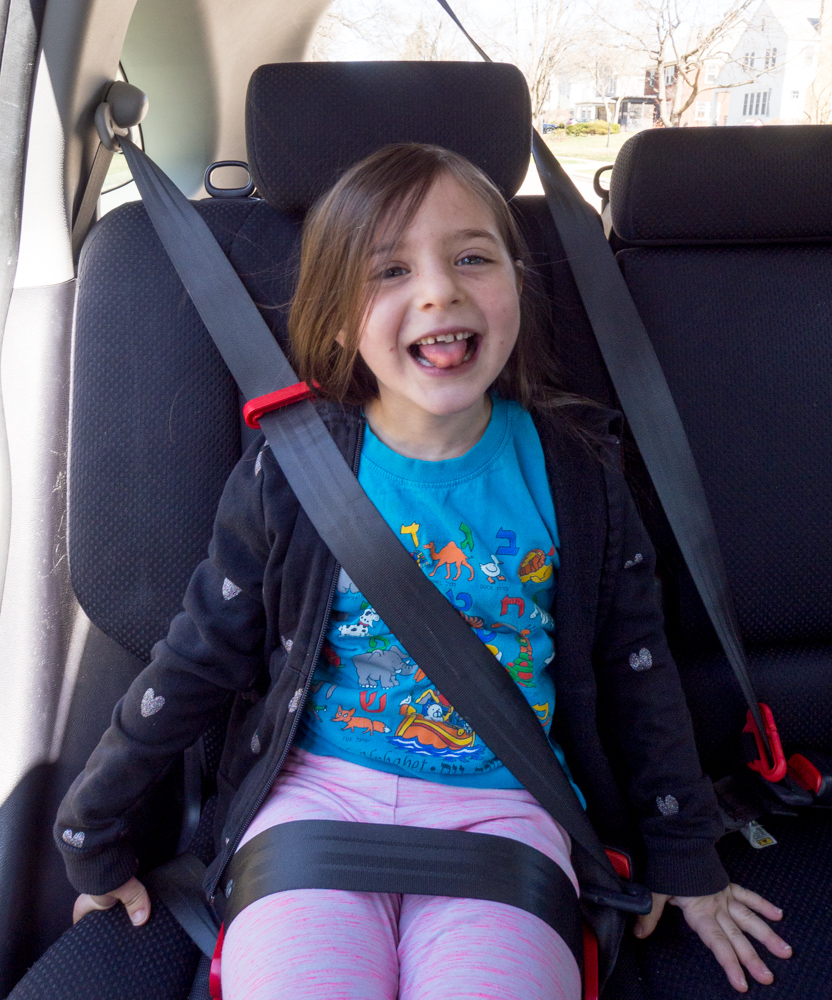
In cars with angled seat bights (the place where the seat and back connect), the mifold has to be partially folded so that half of the booster is resting in the sloped section – leaving only half of the seat to sit on. Many kids have reported that the mifold isn’t especially comfortable for long rides to begin with since there isn’t much padding, and sitting on just half of a seat certainly doesn’t improve the situation. We need our kid to have a comfortable booster seat for road trips or we’ll never hear the end of it.
The time to set up each booster is probably similar. The Bubblebum travel booster seat has to be inflated, but the seat belt guides of the mifold have to be adjusted and take a little longer to use based on the reviews we’ve read. Those guides can also be harder for kids to manage on their own than the ones on the Bubblebum, but we can call it a wash between the Bubble bum vs mifold on ease and speed of use.
While the Bubblebum backless booster car seat isn’t perfect, the belt fit is much more consistent and kids generally find it comfortable even for long rides. It does take up a little more space in the kid’s backpack but that’s a sacrifice we’re willing to make to keep our kid safe and comfortable regardless of what car we’re in as we traipse around the globe.
Bubblebum vs Ride Safer Delight travel vest
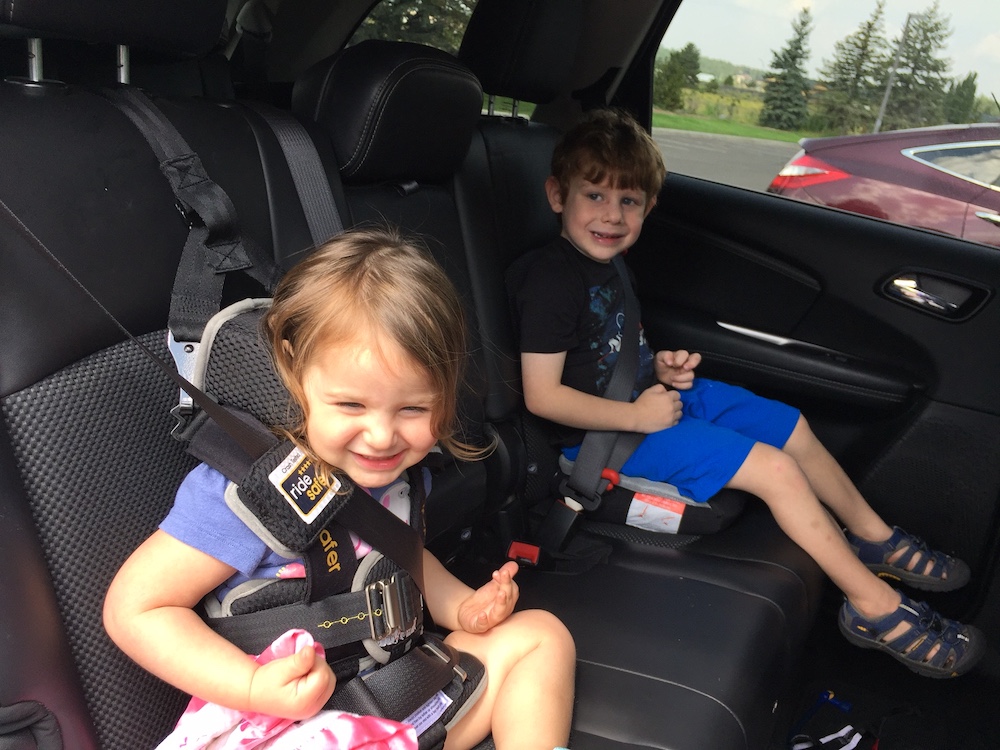
The other excellent alternative to a traditional portable car seat for travel is the Ride Safer Delight travel vest – you can read our full review here, including our thoughts after a year of full-time travel. What’s the difference between these two collapsible car seat options?
In many ways the Bubblebum and the Ride Safer travel vest serve the same purpose: to make an adult seatbelt fit on a child who is otherwise too young. The critical difference is in the target market. While the Bubblebum is a great booster car seat for a 5 or 6 year old, it’s really not ideal for younger kids because it allows them too much freedom of movement so that they may be in an unsafe position when an accident occurs.
The Ride Safer holds both the seatbelt and the child more firmly in place due to its structure and the inclusion of the (option but highly recommended) top tether strap. This is especially important if you have a car sleeper! The Ride Safer travel vest is approved for kids as young as 3, though we found the fit to be better closer to 3.5 years old. The newest Ride Safer Gen 5 runs a bit bigger and won’t fit many kids well until closer to 4 years old.
After using both of these travel booster seat alternatives every day for a year, we like and recommend them both. The Bubblebum is roughly 1lb lighter and is faster and easier to use, but the Ride Safer Delight keeps kids more tightly restrained and is a safer choice for kids under 5 or 6 years old.
Which one should you choose? If your child is younger, smaller or still sleeps in the car I’d go for the Ride Safer travel vest. If your child is mature and not likely to sleep in the car, the Bubblebum car seats are a good option.
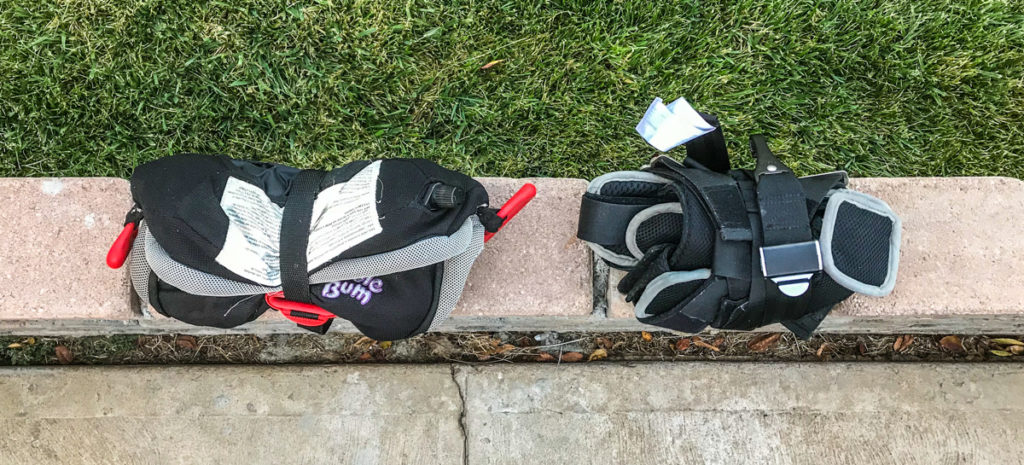
Where to buy the Bubblebum
The Bubblebum blow up booster seat has become pretty popular over the years and you can buy it in a few places:
Bubblebum booster seat FAQs
To inflate the Bubblebum, twist the valve on the back open and give it a few strong breaths. Then twist the valve shut firmly. No need to over-inflate! The Bubblebum crash test is performed both inflated and deflated and it passes both ways.
After inflating, attach the adjustable shoulder belt guide by looping its strap around the webbing that goes across the bottom of the BubbleBum. Scoot it over toward the side where the shoulder belt is positioned.
Place the Bubblebum on the vehicle seat and have your child sit on it. Buckle the seatbelt as normal and place the lap belt through both red seatbelt guides. Then attach the shoulder belt guide to the shoulder belt and shorten it so that the shoulder belt makes full contact with your child’s collar bone and crosses at the middle of the shoulder.
Unscrew the valve on the back of the seat, then roll the seat up starting at the front. Once it’s rolled up completely, twist the valve closed again.
Yes, the Bubblebum booster seat passes the same crash testing as other booster seats on the market.
The Bubblebum width is just 13″, making it the narrowest booster seat that’ll give you a safe, reliable seat belt fit for your child.
Wrapping up
The Bubblebums were a total lifesaver for our family when traveling long-term with a booster rider. If it sounds like the right travel booster seat for your family, check the price and more reviews here.
Looking for something a little more secure for a younger child? Don’t miss our Ride Safer Delight review, or check out the best travel car seats for every age.


Do you think the BubbleBum would be an ok alternative for a 4yr/40lb if the only use is from the airport to the hotel/hotel to Disney and back? It would be a 40 minute drive to/from the airport and (one time) 20 minute drive to/from Disney, with a parent in the back seat between the kids (4 years and 7 years).
Hi April,
Thanks for stopping by! Your child is within the approved limits for the Bubblebum, but I really hesitate to recommend it at age 4 and just 40lbs. That’s the absolute minimum, but we see better seatbelt fit and compliance for kids in backless boosters more in the range of 6. I recommend looking into the Ride Safer Travel Vest (full review here), which will serve your child well over the next several years of travels. The 7yo should do great with the Bubblebum!
Safe travels,
Melissa
Thank you for your response! I really appreciate it 😊
My pleasure! Feel free to reach out if you need any more help.
Safe travels,
Melissa